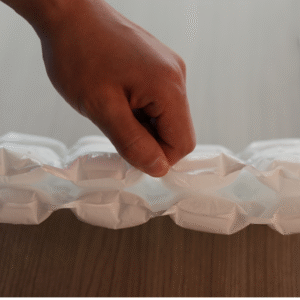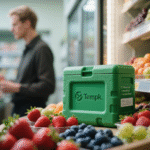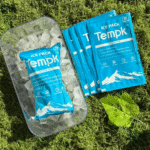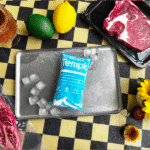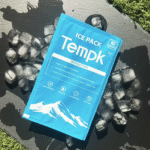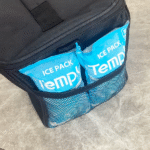Pacote de Gel vs Gelo Seco: Qual solução de cadeia de frio é melhor para sua remessa?
Ao enviar produtos sensíveis à temperatura, a escolha da solução de resfriamento -pacotes de gel ou gelo seco—pode impactar significativamente a segurança da sua remessa, custo, e desempenho. Este artigo analisa as principais diferenças entre essas duas opções, ajudando você a decidir qual é o ideal para suas necessidades de cadeia de frio em 2025.
-
O controle de temperatura capacidades de pacotes de gel e gelo seco
-
Considerações de custo para ambas as opções, incluindo reutilização e impacto ambiental
-
O preocupações de segurança associado a cada solução
-
Os melhores cenários para o uso de embalagens de gel e gelo seco no transporte da cadeia de frio
O que são Pacotes de gel e gelo seco?
Pacotes de gel: Uma visão geral
Pacotes de gel são flexíveis, soluções de resfriamento reutilizáveis que contêm um gel não tóxico dentro de um invólucro de plástico. Eles funcionam mantendo uma temperatura moderada, normalmente entre 32°F e 50°F (0°C a 10 °C), tornando-os adequados para produtos refrigerados como comida, cosméticos, e produtos farmacêuticos que requerem refrigeração, mas não congelamento.
Gelo Seco: Uma visão geral
Gelo seco, feito de dióxido de carbono congelado (CO2), sublima em -109.3°F (-78.5°C), tornando -o ideal para produtos congelados como carne, frutos do mar, e amostras biológicas. É a opção ideal quando os produtos exigem temperaturas extremamente baixas por longos períodos.
Como os pacotes de gel e o gelo seco se comparam?
Faixa de temperatura: O que mantém seus produtos mais frescos?
-
Gelo Seco: Ideal para temperaturas congelantes, mantendo os itens em abaixo de zero níveis.
-
Pacotes de gel: Melhor para resfriamento moderado, normalmente mantendo temperaturas entre 32°F e 50°F (0°C a 10 °C).
Duração: Quanto tempo eles duram?
-
Gelo Seco: Sublima com o tempo, geralmente oferecendo menor duração de resfriamento, a menos que seja embalado de forma eficiente.
-
Pacotes de gel: Forneça mais tempo, resfriamento mais lento, mas não consegue atingir as temperaturas extremas que o gelo seco oferece.
Segurança e Manuseio: O que é mais seguro para sua equipe?
-
Pacotes de gel: Seguro para tocar e manusear, sem necessidade de equipamento especial.
-
Gelo Seco: Requer luvas e ventilação adequada devido ao frio extremo e ao potencial de Acúmulo de CO2, que pode ser perigoso em espaços fechados.
Comparação de custos: O que é mais econômico?
| Solução de resfriamento | Custo inicial | Reutilização | Custo de envio | Eficiência geral de custos |
|---|---|---|---|---|
| Pacotes de gel | Mais baixo | Reutilizável | Mais baixo | Econômico para remessas de curto prazo |
| Gelo Seco | Mais alto | Uso único | Mais alto | Caro para remessas de longo prazo |
-
Pacotes de gel são mais solução econômica para empresas que procuram resfriamento de curto prazo sem a necessidade de temperaturas ultrabaixas.
-
Gelo Seco é normalmente mais caro antecipadamente e é um produto de uso único, tornando-o mais adequado para remessas que exigem temperaturas ultrabaixas por longos períodos.
Preocupações de segurança: O que é mais seguro de manusear?
-
Pacotes de gel: Mais seguro para manuseio, sem emissões tóxicas ou riscos extremos de frio. Eles podem ser tocados e reutilizados com segurança.
-
Gelo Seco: Requer manuseio especial. Frostbite pode ocorrer por contato direto, e o gelo seco pode deslocar o oxigênio em espaços confinados, potencialmente causando asfixia.
Quando você deve usar pacotes de gel?
Pacotes de gel são perfeitos para:
-
Remessas de curto prazo onde o controle de temperatura não é crítico
-
Produtos que precisam resfriamento moderado (por exemplo, alimentos não perecíveis, cosméticos, produtos farmacêuticos)
Quando o gelo seco é a melhor opção?
Gelo seco é essencial quando:
-
Envio Alimentos congelados como carne, frutos do mar, ou sorvete
-
Manuseio amostras biológicas ou produtos farmacêuticos que requerem temperaturas extremamente baixas
-
Transportando mercadorias distâncias mais longas ou durações de envio estendidas
Tendências emergentes no transporte marítimo da cadeia de frio: O que esperar em 2025
À medida que a indústria da cadeia fria evolui, diversos inovações estão melhorando a eficiência e a sustentabilidade das soluções de refrigeração:
-
Alternativas sustentáveis: Pacotes de gel ecológicos e embalagens biodegradáveis estão ganhando popularidade.
-
Tecnologias avançadas de monitoramento: Sistemas de monitoramento de temperatura em tempo real alimentados por IoT garantem melhor rastreamento e conformidade.
-
Materiais de mudança de fase (PCMs): Esses materiais oferecem controle de temperatura consistente por períodos mais longos, tornando-se uma alternativa viável para pacotes de gel e gelo seco.
Perguntas frequentes
Q1: Qual solução dura mais: pacotes de gel ou gelo seco?
-
O gelo seco tende a durar mais, especialmente para temperaturas ultrabaixas, enquanto os pacotes de gel são mais eficazes para resfriamento moderado por um período mais longo.
Q2: Os pacotes de gel são seguros para remessas de alimentos??
-
Sim, pacotes de gel são seguros para enviar alimentos, especialmente não perecível itens que precisam ficar frescos, mas não congelado.
Q3: Posso usar gelo seco para itens resfriados?
-
O gelo seco não é recomendado para itens resfriados, pois fornece frio extremo. Os pacotes de gel são mais adequados para manter os itens frescos sem congelá-los.
Conclusão e recomendações
Escolhendo entre pacotes de gel e gelo seco depende das necessidades de temperatura da sua remessa. Pacotes de gel são perfeitos para resfriamento moderado e são mais econômico para remessas de curto prazo. No entanto, gelo seco é necessário para remessas que exigem temperaturas ultrabaixas e durações mais longas. Avaliando o tipo de produto e as condições de envio, você pode tomar uma decisão informada.
Dica prática: Se o seu negócio é novo na logística da cadeia de frio, comece com pacotes de gel para produtos não congelados e experimente gelo seco para aqueles que necessitam de frio extremo.
Sobre Tempk
No Tempk, somos especializados em fornecer soluções inovadoras de cadeia de frio para todas as suas necessidades de transporte. Nossos produtos, incluindo pacotes de gel e gelo seco, são projetados para manter o integridade de seus produtos durante o trânsito. Nós priorizamos sustentabilidade e eficiência de custos em todas as nossas soluções.
Para aconselhamento especializado, entre em contato conosco hoje!






